
The Barbell Front Squat Guide (for Building Muscle)
The barbell squat is the strength training lift. It’s the best lift for bulking up your quads, glutes, and calves, and it stimulates more overall muscle mass than any other lift, with the possible exception of the deadlift.
There are different ways of squatting, each with different pros and cons. This article has nothing to do with powerlifting or Olympic weightlifting. Instead, we’re using the squat to stimulate muscle growth—to get bigger, stronger, fitter, and better looking. For this, the barbell front squat is the best. That’s a controversial claim, we know. But we’ll show you why, then how.
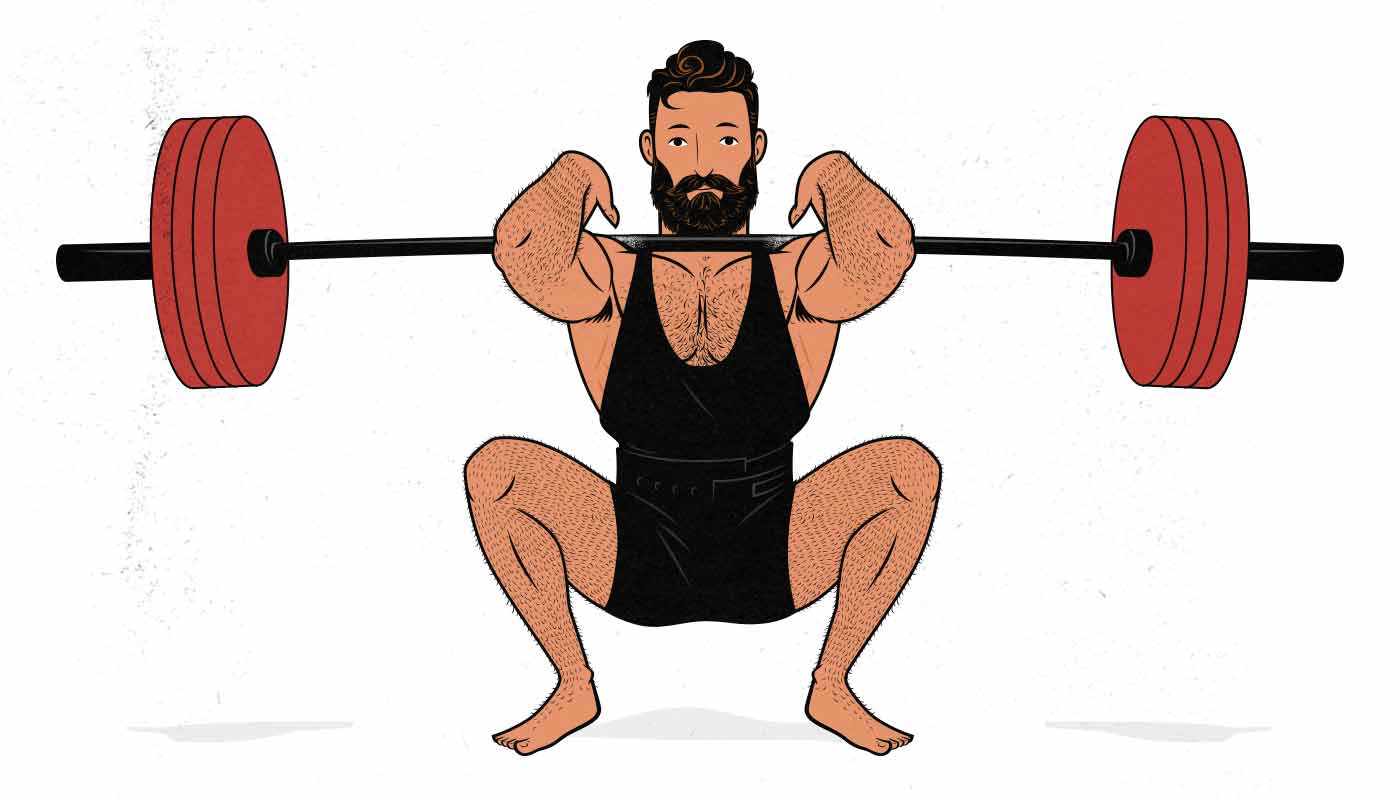
What is the Barbell Front Squat?
The front squat is a squat with the barbell held in front of you, resting on the crease between your shoulders and your collarbones, up against the front of your neck.
Bit of a weird way to hold a barbell, yes. But having the barbell in front of you allows you to maintain a more upright torso, freeing up space in your hips and allowing you to sink even deeper into your squat. This puts a greater stretch on your quads, which is great for stimulating muscle growth. Holding the barbell in front of you also gives your upper back a greater challenge, turning the squat into a full-body lift.
Because we’re squatting deeper and because we need to support the weight with our upper backs, the front squat is a lighter squat variation. Most people can low-bar squat about 25% more weight than they can front squat. As a result, the front squat isn’t viable in powerlifting. It doesn’t allow us to lift enough weight.
Where the front squat excels is in hypertrophy training, where the goal is to stimulate muscle growth. It works the knees through the deepest range of motion, which is ideal for bulking up the quads, and it works our upper bodies hard enough to stimulate muscle growth all through our torsos. And because of how deep the range of motion is and how much muscle growth it stimulates, the front squat is also popular in Olympic weightlifting and among athletes.
How to Do the Front Squat
If your goal is to gain overall size and strength, you’ll want to squat less like a powerlifter, more like an Olympic weightlifter. That means squatting with a more upright torso, sitting your butt “down” instead of “back,” and holding the barbell in front of your body instead of on your back. The front squat is perfect for this.
Here’s a video of Marco teaching the front squat:
As you do your front squats, you might want to keep a few cues in mind:
- Keep your belly braced and your spine neutral.
- Don’t sit back into the squat; sit down into the squat. Think about bringing your butt down. The more upright you can keep your torso, the better.
- Keep your elbows high.
- Sink as deep as you can, even if it means lifting lighter weights. The goal with the front squat is to work your knees through a complete range of motion, even if that limits how much weight you can lift.
However, the front squat is a brutal lift with a rough learning curve. I’d say it’s a lift that only a mother could love, but we’ve asked plenty of mothers to try it. They don’t like it either. It gets worse, too. Most people don’t have the wrist mobility to hold the barbell properly when they first try the front squat. They try it, can’t get into the right position, feel like they’re being choked to death, and abandon it forever.
The front squat looks like a painfully awkward way to strangle yourself with a barbell.
–Michael Matthews, Legion Athletics
If you do some wrist stretches during your warm-up routine, you’ll probably be able to get at least a couple of fingers under the bar. That’s enough to start with. And yes, it might feel awkward up against your neck, but that pain will pass after you get used to the lift.
If you’re really having trouble learning how to do the front squat, instead of switching to the back squat, you might want to start with the goblet squat instead. The movement pattern is the same, but it’s a bit easier to get into the correct position (at the cost of being able to lift less weight).
What Muscles Does the Front Squat Work?
Main Muscles Worked
Front squats are best at bulking up your quads. The lift is designed to allow you to sink deep, work your knees through a full range of motion, and challenge your quads under a deep stretch.
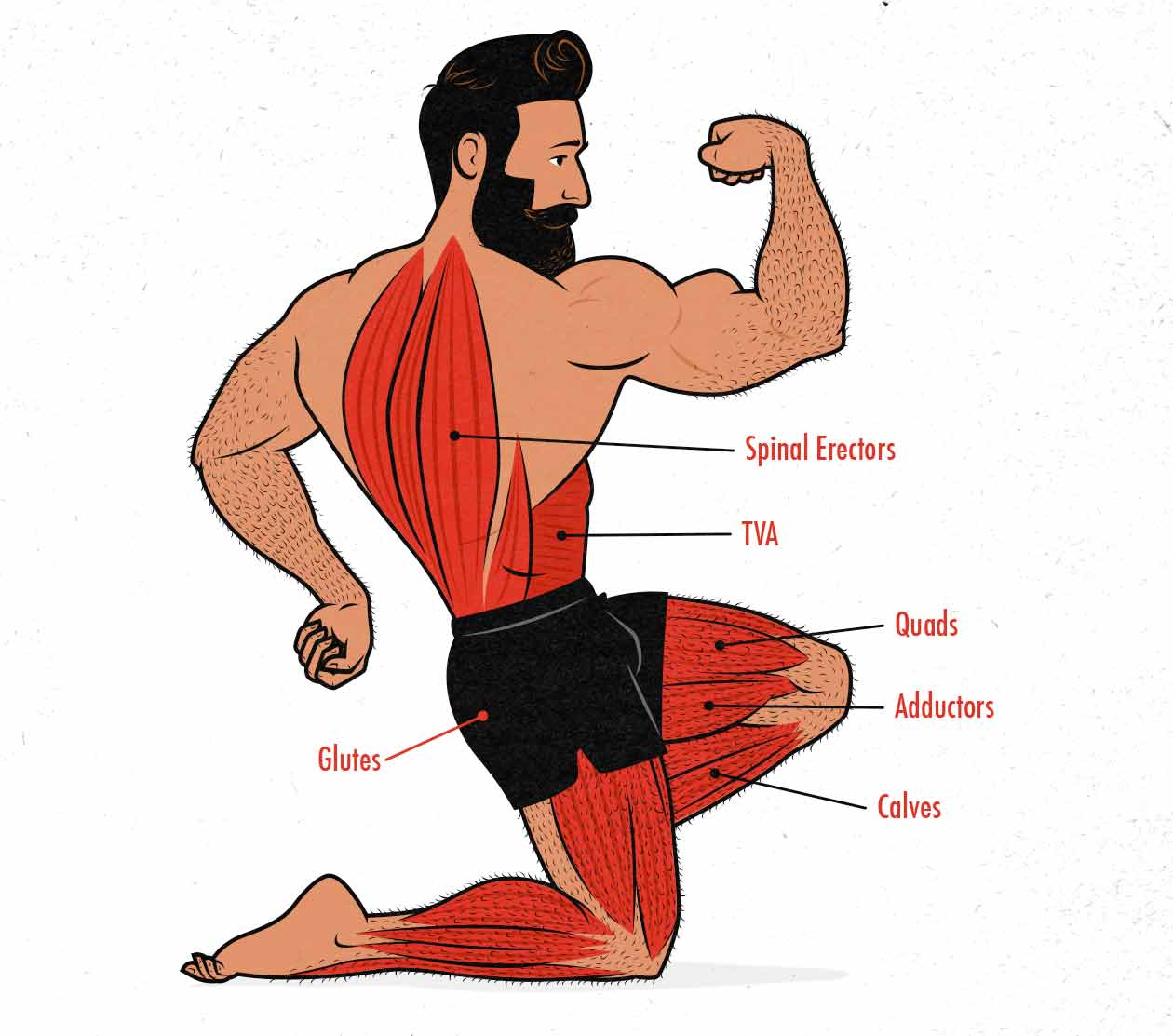
There are two other muscles that the front squat works, though: your glutes and the spinal erectors in your upper back. Unlike a deadlift, we aren’t working your hips through a full range of motion, meaning that the front squat isn’t ideal for building bigger hips, but it will still help them grow.
For the spinal erectors in your upper back, the front squat is perfect. It puts them under a great load and trains them isometrically, having them hold your spine in a neutral position.
Do Squats Work 200 Muscles?
Like the deadlift, front squats are a great exercise for working your body from your neck down to your toes. In fact, the squat’s claim to fame is that it stimulates over 200 muscles at the same time. Is that actually true? Sort of. But that’s the wrong way to think about the squat.
The squat does indeed work hundreds of muscles, but that’s not really what we’re interested in. Most of those muscles aren’t limiting factors, they won’t be taken anywhere close to failure, so they won’t grow. To illustrate this, imagine doing biceps curls with 10-pound weights for 10 repetitions. Your biceps would be worked, yes, but you’d still be fifty reps away from failure. Your biceps won’t grow from that. It’s not challenging enough.
Now let’s consider how hard your lats are being worked when you squat. Your lats put in work to help stabilize your spine while doing front squats, yes, but they won’t be challenged enough to stimulate any muscle growth. If you want to bulk up your lats, that’s where chin-ups come in.
Do Squats Work the Hamstrings?
Yes, front squats work your hamstrings, but not hard enough to stimulate any muscle growth. A 2009 study found that our hamstrings only contract about 27% as they’re able to while squatting, which isn’t nearly enough to provoke any muscle growth. Adding supporting evidence, another study found that after seven weeks of squatting, the participants gained a significant amount of muscle in their quads but none whatsoever in their hamstrings.
To build bigger hamstrings, it’s better to use lifts emphasizing bending at the hips, such as the deadlift, Romanian deadlift, and good morning. That’s one reason why it helps to have an even balance between squat and deadlift variations in a program.
Are Squats the Best Lift for Building Muscle?
Squats Stimulate the Most Overall Muscle Growth
Squats are often considered the best exercise for gaining overall muscle mass. We’ve already covered the myth that squats bulk up over 200 muscles. Over 200 muscles are active, but that doesn’t mean they’re being worked hard enough to provoke muscle growth.
Despite the hundreds of muscles that are active while squatting, squats do the best job of working your quads and glutes. And with barbell front squats, add spinal erectors. That might not sound like much… until you look at how massive those muscles are. Here are our muscles organized by muscle size (as analyzed by Menno Henselmans, MSc):
- Quads: 1800 cm³
- Glutes: 1200 cm³
- Calves: 850 cm³
- Hamstrings: 700 cm³
- Shoulders: 400 cm³
- Chest: 250 cm³
- Lats: 250 cm³
- Triceps: 250 cm³
- Traps: 200 cm³
- Biceps: 100 cm³
- Forearms: 100 cm³
What we’re seeing here is that the squat works the two biggest muscles in your body—hard. That’s far more than half of your overall muscle mass, and that’s without even counting your adductors, calves, and spinal erectors, which can also be brought close enough to muscular failure to provoke muscle growth.
So, even though the squat won’t bulk up 200 different muscles, it does bulk up the two biggest muscles in your body, which make up more than half of your overall muscle mass. This means that squats are indeed the best lift for building muscle.
Squats Tax the Cardiovascular System
Now, why does it matter how much muscle mass a lift works? The bench press works a fairly small amount of overall muscle mass, but that doesn’t stop it from being a great lift for bulking up your chest. So why should you care about the sheer amount of muscle mass being worked by the squat?
What makes the squat special is that it goes beyond strength training and bodybuilding. It works so much muscle mass that it taxes your anaerobic and cardiovascular systems to their limits. As you grind out your reps, your anaerobic system will be pummelled into the ground. Then, when you collapse into a puddle of agony between sets, your cardiovascular system goes into overdrive to deliver oxygen to those drained muscles, preparing you for the next set. That’s why your heart thumps out of your chest after a hard set of front squats.
So, because of the sheer amount of muscle being worked, front squats aren’t just great for gaining strength and muscle mass; they’re also an incredible tool for improving your overall health, work capacity, and general fitness. In fact, doing 10-rep sets of front squats isn’t so dissimilar from doing high-intensity interval training (HIIT).
Squats Help Prevent Fat Gain While Bulking
The next advantage of squats is that because they stimulate so much overall muscle growth, they also help to prevent fat gain. After all, if more calories are being invested into bulking up your quads and glutes, that leaves fewer available to spill over into fat gain.
Front Squats vs Back Squats
Front Squats are Better for the Quads
The barbell front squat keeps our torsos more upright, allowing us to sink deeper, working our quads through a larger range of motion. The back squat optimizes our leverage, allowing us to lift more weight through a shorter range of motion.
The reason that a front squat allows you to sink deeper is that it frees up more space between your hips and femurs, like so:
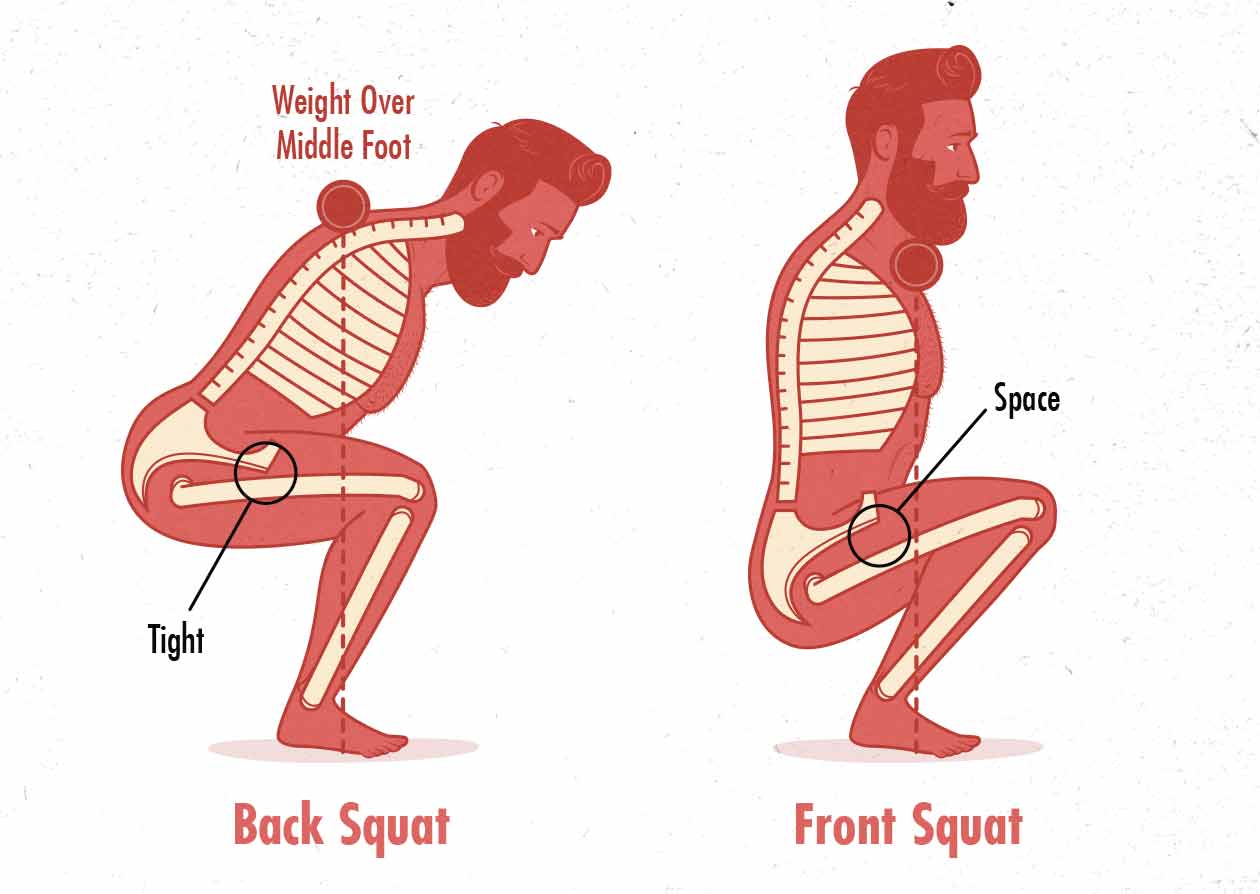
On the left, we see a low-bar back squat done to parallel depth, as per the recommendations found in Starting Strength. On the right, we see a deep front squat, as an Olympic weightlifter would do it. That extra space in your hips will allow you to sink much deeper.
Now, why does this matter? For starters, the front squat reduces the risk of injuring your hips, but that’s rare anyway. Most people can learn to do back squats without injuring their hips. The main benefit of front squats is that the deeper you can sit into your squat, the deeper you’ll stretch your quads and the more muscle growth you’ll stimulate.
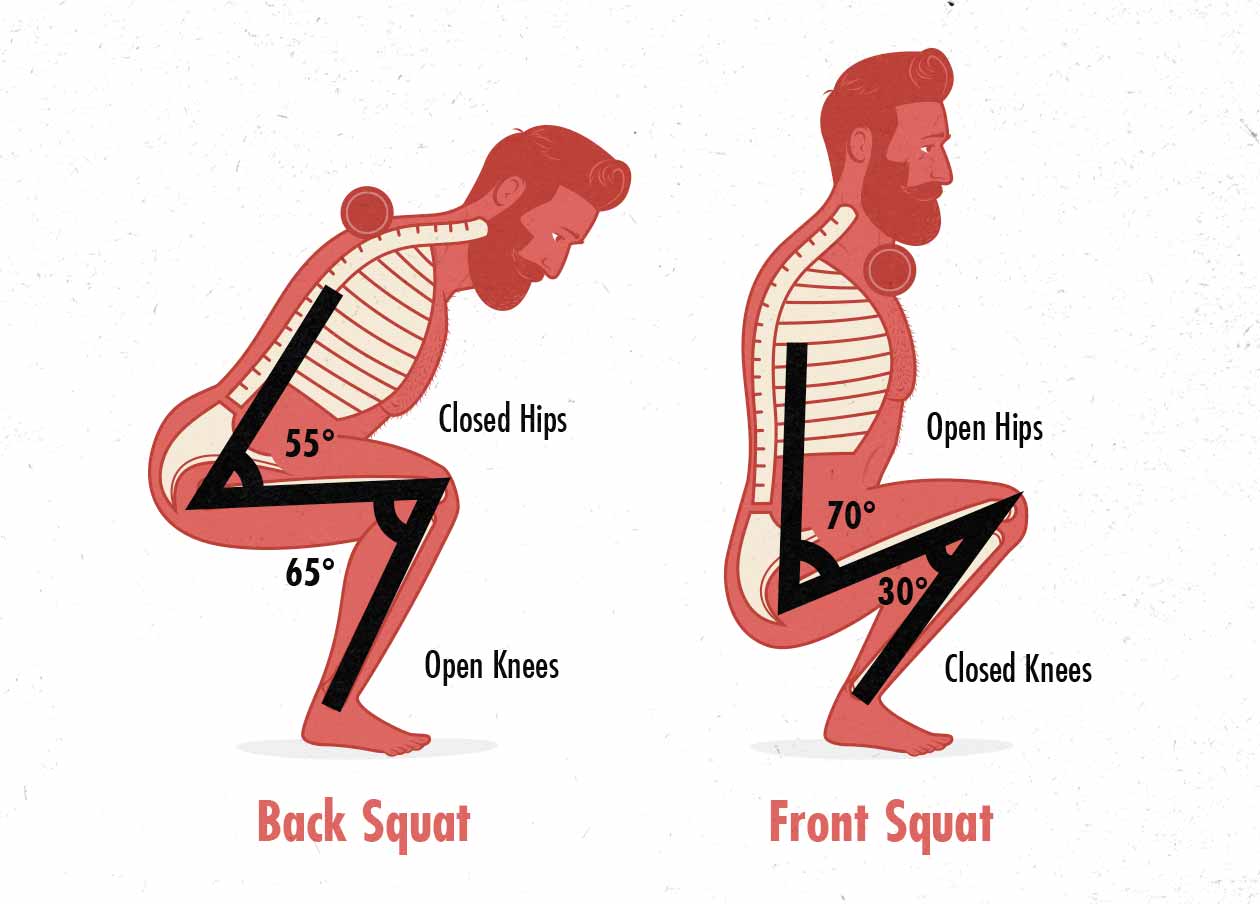
If we look at the difference in knee angle, the back squat works the quads through a 115° range of motion, whereas the front squat works the quads through a 150° range of motion. These angles will vary from person to person, of course, but the front squat almost always allows us to use a deeper range of motion.
Back Squats are Better for the Hips
With the back squat, there’s less bend at the knees and more at the hips. This becomes even more evident if we add the moment arms at the hardest part of the lift:
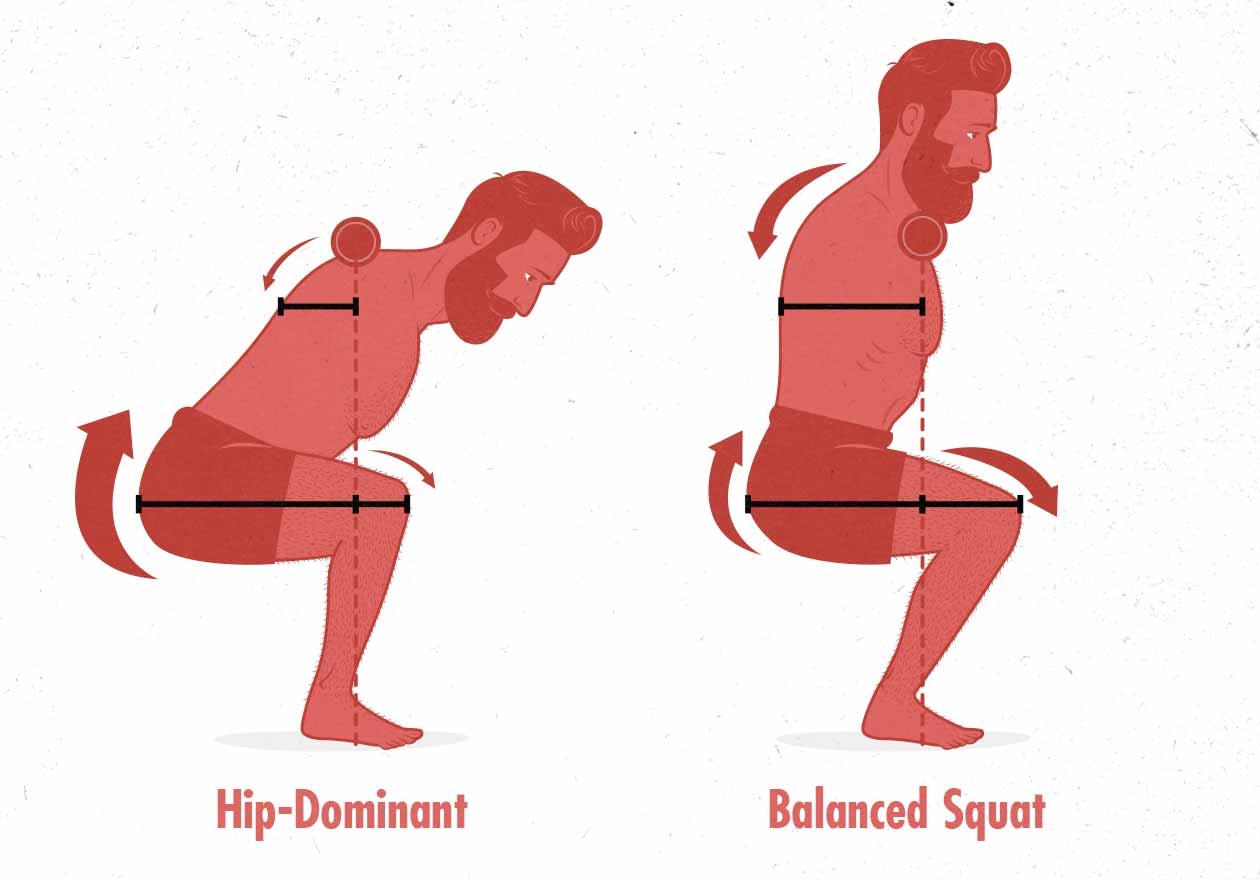
If you aren’t familiar with physics, unfortunately, this might look like physics. What we’re seeing is that the back squat puts the hips in a position of poor leverage at the sticking point, forcing them to work harder to lift the barbell. As a result, the hips get a better growth stimulus… at the expense of the quads.
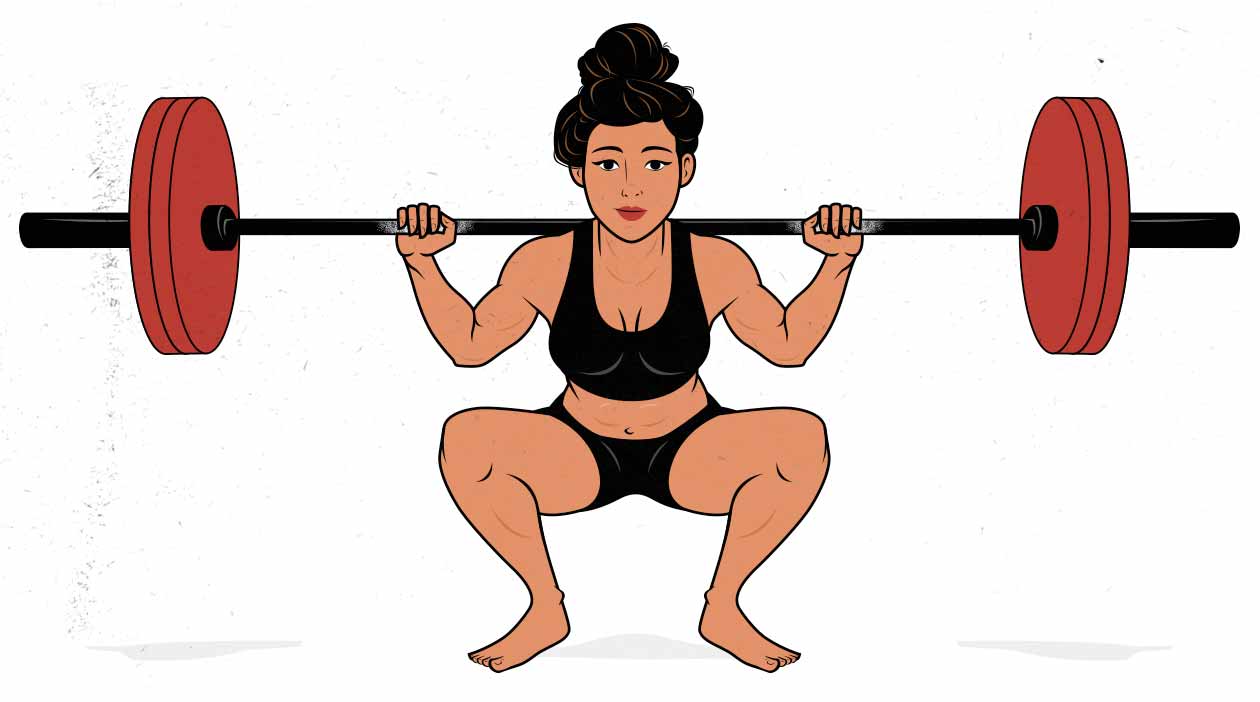
If you wanted to prioritize hip growth over quad growth (as many of our female clients do), that might be a reason to favour back squats. But we have the deadlift to take care of your hips. We don’t need to turn the squat into a hip lift when we have another lift that does it better.
The Front Squat is Better for the Upper Back
If we look at the front squat, the moment arms are spread more evenly between our quads, hips, and spinal erectors. Not only will our quads be forced to work harder, but we also see our upper backs coming into play:
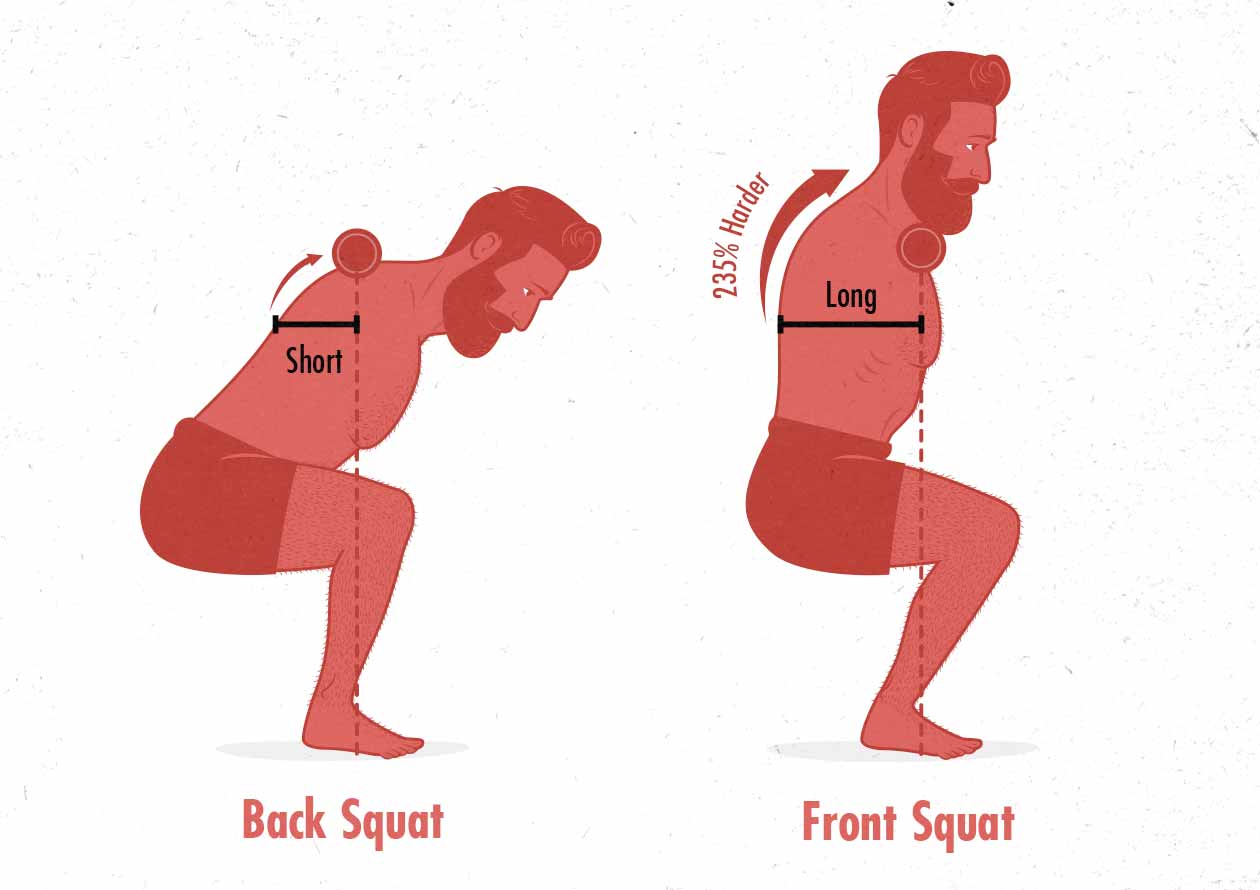
Holding the barbell in front of our bodies increases the moment arm for our thoracic spines, putting around 235% more load on our upper back muscles (as calculated by Greg Nuckols, MA), thus stimulating a ton of muscle growth in our upper backs.
Front squats are, hands down, the best squat variation for building upper back strength.
Greg Nuckols, Stronger by Science
In fact, front squats stimulate our spinal erectors even more than isolation lifts that are specifically designed to target that area, such as back extensions (study). This extra upper-back growth makes front squats so good for improving our posture and aesthetics.
Back Squats Are Heavier
Most people front squat about 15–25% less weight than they can back squat. Part of this is because of the extra range of motion. Part of this is because the front squat is challenging for our upper-back muscles. This makes the front squat horrendous for powerlifting. No powerlifter wants to front squat 300 when they could be back squatting 400.
Front Squats Might Be Safer
Finally, the front squat forces good technique. As soon as your technique begins to crumble, the weight will simply roll off your shoulders. You won’t be forced to grind out the rep with a rounded back, you won’t get pinned, and there’s less stress on your lower back. This makes the front squat the safest (heavy) barbell squat variation, allowing you to push harder without needing to worry about injuring yourself.
Which Squat Variation is Best for Building Muscle?
Put simply, front squats do a better job of training our quads and upper back, but at the cost of forcing us to lift lighter weights. That reduction in weight is enough to cancel out some of the benefits. That makes it hard to know which variation stimulates more overall muscle growth.
Fortunately, if we look at a study by Bret Contreras, Ph.D., we see that barbell front and back squats produce the same amount of lower-body growth. That means that with front squats, we’re getting the extra upper-back growth without any real downside.
And as we’ve discussed above, there are several other advantages to the front squat:
- Deeper range of motion: Front squats are done with a more upright torso, which makes it easier to use a larger range of motion, and makes it less likely that you’ll jam your hips into your femurs.
- Better for your upper back and core: Because the barbell is held in front of you, front squats do a better job of bulking up your upper back, which is going to have greater carryover to your deadlift. They also do a better job of strengthening your core, which has great carryover to your push presses.
- It’s great for your spine: squatting with an upright torso puts your spine under plenty of compressive force, which gives you some great adaptations, but also less shear stress. This makes it pretty safe and easy on your spine.
- It forces better squatting technique: Poor front squat technique can lead to the barbell falling off your shoulders. This means that even when lifting heavy and even when approaching failure, front squats continue to reinforce good technique. This keeps the lift safe even as you push yourself hard.
- It’s better for your posture and shoulders: A typical back squat requires developing shoulder mobility so that you can crank them backwards, which is fine, but it won’t improve your shoulder health. Front squats, on the other hand, require developing t-spine mobility so that you can get into a proper rack position, which improves your upper back (t-spine) mobility and posture. It’s a better shoulder adaptation.
- Just as much quad and glute development: front squatting means lifting less weight, but since you’re lifting through a larger range of motion, it still produces the same overall amount of muscle growth in your quads and glutes (study).
- It’s easier on your knees: the front squat is easier on your knees (study). Admittedly, that doesn’t matter for most people, but it’s certainly an advantage for those who already have cranky knees.
- It’s less demanding on your lower back: this would be a bad thing if we weren’t also deadlifting, given that we want the benefits of greater spinal loading (such as denser bones and a more resilient spine). But since we’re already training that area so hard with our deadlifts and rows, the front squat gives your lower back a well-earned break.
This leads me to the tentative conclusion that front squats are the better default squat variation for bodybuilding, hypertrophy training, and building muscle in general. Not that back squats are bad—they aren’t. Just that front squats are often even better.
Barbell Front Squat Alternatives
At this point, it’s no secret that we love the front squat and that the front squat returns that love in spades, helping us build more muscle more easily. But we’ve already sung that ballad. And besides, front squats aren’t for everyone. Maybe you’re lifting without access to a barbell, or perhaps your particular anthropometry suits another squat variation better. That can happen.
Plus, if your front squat progress ever stalls or you get sick of grinding away at the same squat variation, it might be worth switching to another way of squatting just to freshen things up.
Goblet Squats (Beginner Dumbbell Variation)
Dumbbell goblet squats are done by picking up a dumbbell and holding it in front of your chest. The weight is in almost the same place as in the front squat, which keeps the torso upright and challenges the upper back. The difference is that you’re holding the dumbbell in front of you instead of letting it rest on your shoulders, which requires far more shoulder and biceps strength.
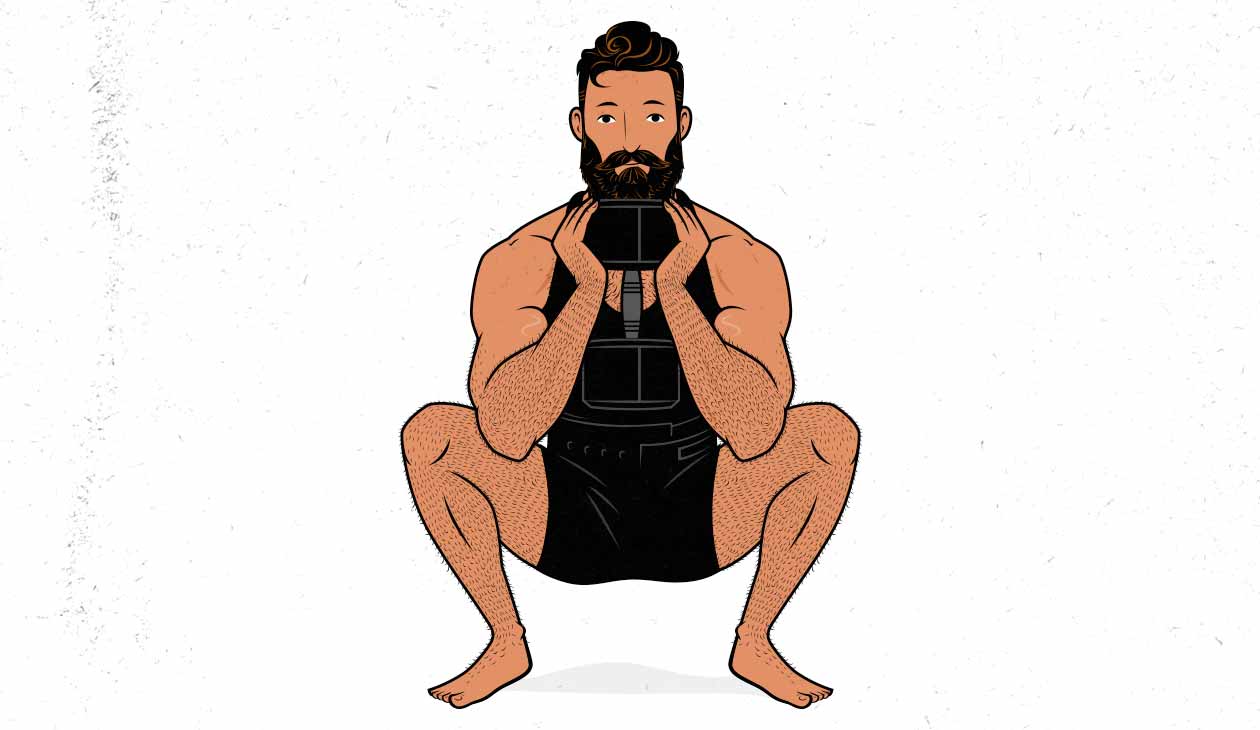
Goblet squats are one of the best bulking lifts of all time, for a time. They work the same muscles as front squats, but they add in your biceps and all of the muscles in your shoulder girdle. It’s a true full-body lift. The only problem is that you’ll eventually grow too strong for them.
We use goblet squats as a main squat variation in the first couple of phases of our Bony to Beastly Bulking Program, and they’re perhaps our single favourite squat variation. However, because of the sheer amount of muscle mass the goblet squat works, once you can do more than ten reps with the heaviest dumbbell, it will become more of a cardiovascular exercise than a bulking exercise.
Now, it’s important to improve your cardio as you bulk up, so even then, goblet squats can still have a role in a good bulking routine, but they’ll stop stimulating as much muscle growth. If you can’t do ten reps with the heaviest dumbbell yet, though, choose these as an assistance lift.
Racked Squats (Heavy Dumbbell Variation)
If you’re training at home without a barbell, eventually, you’re going to run into the problem where you grow too strong for the goblet squat and need to find a more challenging squat variation. One approach is to start working one leg at a time, such as with Bulgarian split squats. Another approach is to start holding twice as many dumbbells:

The idea here isn’t to hold the weights up, which would be super heavy, but instead to rest the weights upon our shoulders, the same way we do when front squatting. The lift will still be hard on our cores and backs, but that should keep it easier on our arms and shoulders, allowing us to stimulate our quads and glutes properly.
If you have access to kettlebells, there’s also the option of holding two kettlebells in a racked position, like so:
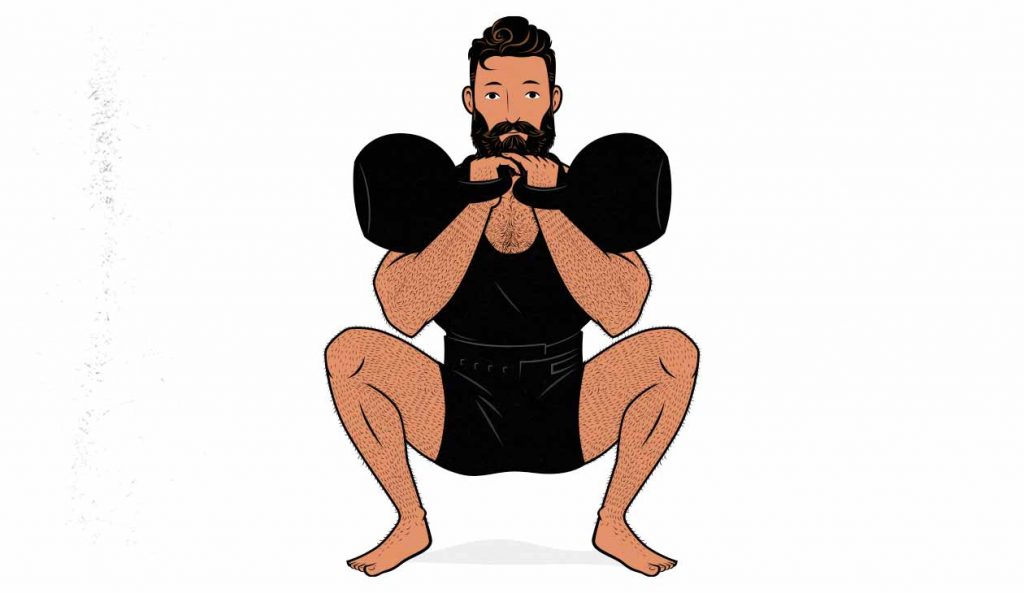
Again, the idea isn’t to hold the kettlebells but rather to rest them in that racked position. Fortunately, kettlebells are designed with this position in mind, so it should actually feel quite a bit more natural than it does with dumbbells.
The only trick with kettlebells is that we might not have a pair of kettlebells that both weigh the same amount. Perhaps we have one 75-pounder and one 50-pounder. In that case, no problem; it just becomes an “offset” squat, like so:

Our legs will work just as hard, but now we’ve got our obliques working to keep our torsos from leaning to the side. That’s a great bonus. We just need to remember to alternate sides from set to set. Or, if you prefer, you can alternate in the middle of each set.
Once we’re talking about holding two dumbbells or kettlebells, each going up to 75–100 pounds, and with sets going as high as twelve or even twenty reps, these become a long-term squat alternative for people without access to a barbell. If we become too strong for these, though, we can always move on to two-dumbbell Bulgarian split squats.
Low-Bar Squats (Powerlifter Variation)
The low-bar squat is the biggest and most famous squat variation. It’s the squat variation that you’ll find in both Starting Strength and StrongLifts 5×5, and it’s the squat that you’ll see every powerlifter doing. It’s the squat that holds all of the world records.
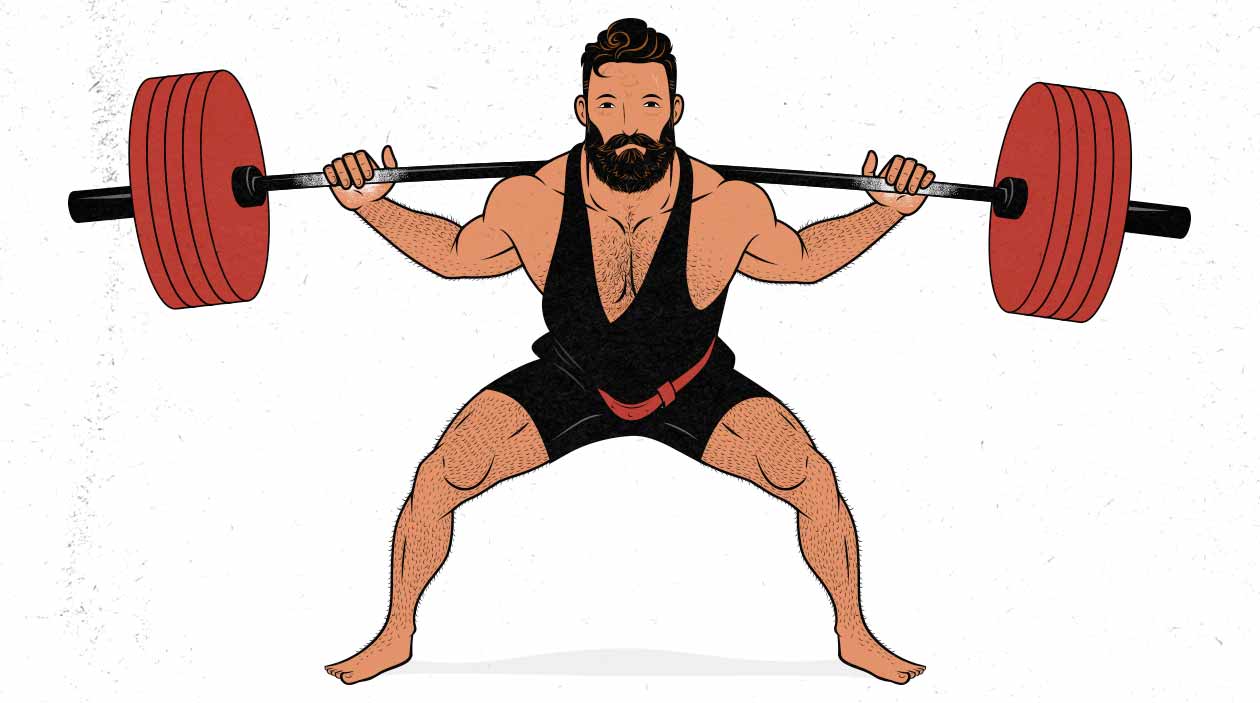
The low-bar squat has you positioning the barbell lower on your upper back, usually on top of your rear delts, like so:
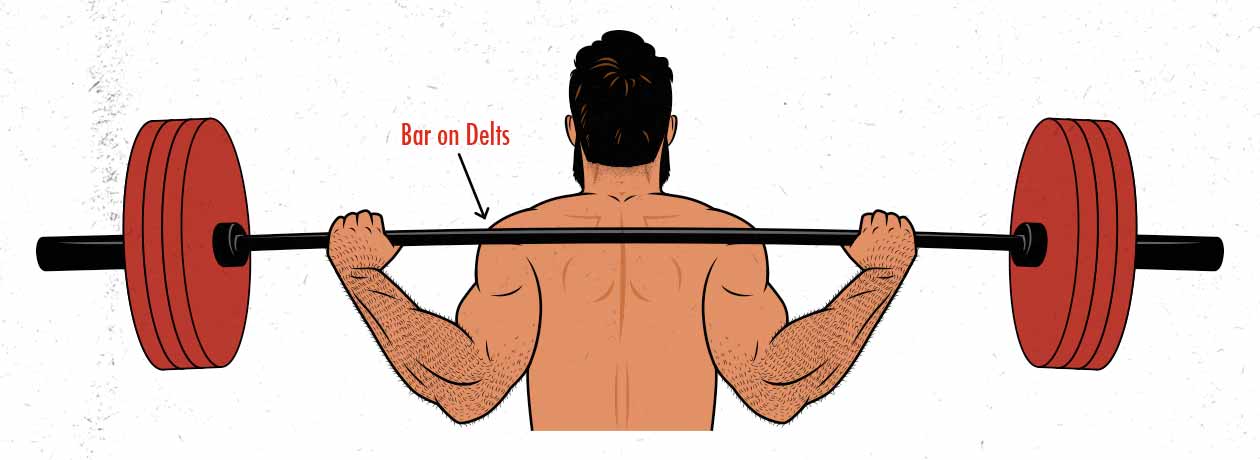
This “low-bar” position allows your hips to bear the brunt of the load and requires the least amount of upper-back strength (study). This allows most people to low-bar squat about 10% more weight than they can high-bar squat and about 25% more weight than they can front squat.
You’d think that the extra emphasis on the hips would come at the expense of the quads, but it doesn’t. The extra weight on the barbell makes up for the smaller moment arm. So, just like the other squat variations, it’s fantastic for our quads.
However, the low-bar squat does have its downsides. With the low-bar squat, we bend more at the waist and less at the knees. The problem is that extra bend at the waist can cause our hips to jam up against our femurs, reducing our range of motion and possibly leading to hip issues down the road. It’s a rare injury among the general public, but it’s relatively common for powerlifters.
Minimizing the involvement of the back muscles also makes the low-bar squat more of a specialized lower-body lift instead of an all-around size and strength builder. It becomes more about developing hip drive and less about developing overall strength.
Is the low-bar squat good for prioritizing hip growth? One reason someone might favour the low-bar squat is that they want proportionally bigger hips. We see this a lot with our female clients. The low-bar squat would allow them to “sit back” into the squat and then drive the barbell back up with their hips. That will indeed shift more emphasis to the hips while squatting.
Furthermore, because there’s so much emphasis on bending at the hips, the low-bar squat trains our glutes through a larger range of motion, similar to a deadlift. That’s great for building up a bigger, rounder butt.
Conclusion: This is a great squat for powerlifters and hip growth. However, if you’re not a powerlifter, and if you’re not trying to prioritize hip development, this probably isn’t the squat for you.
High-Bar Squats (General Strength Variation)
The high-bar squat bridges the gap between the low-bar and the front squat, and is oft considered the best all-purpose squat.
For starters, the high-bar squat has us positioning the barbell higher up on our backs, on top of our traps, like so:
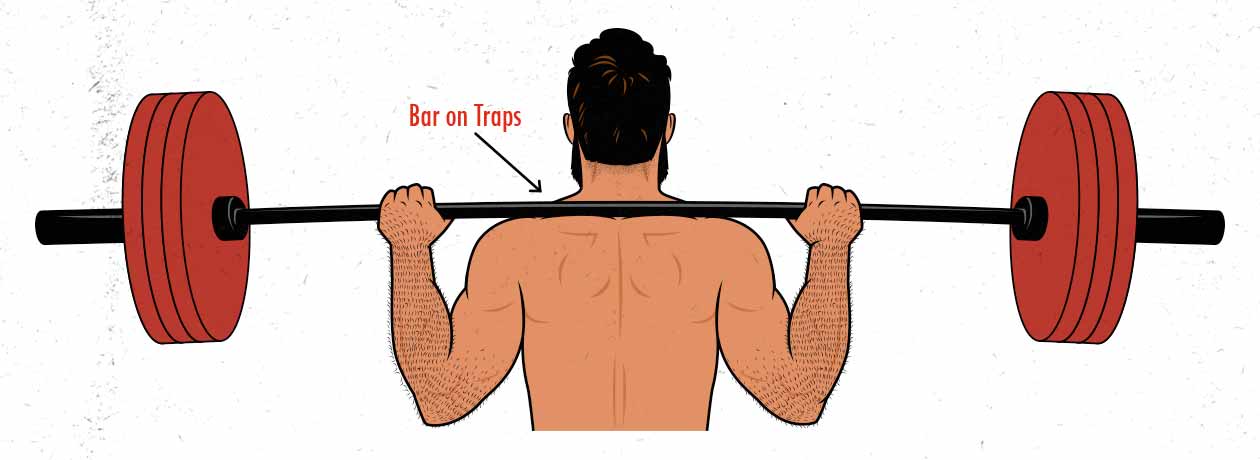
This higher position requires less shoulder and wrist mobility, and it allows for a narrower grip and a sturdier upper-back contraction. The main difference between high-bar and low-bar squats, though, is that it changes our centre of gravity, allowing for a more upright torso:
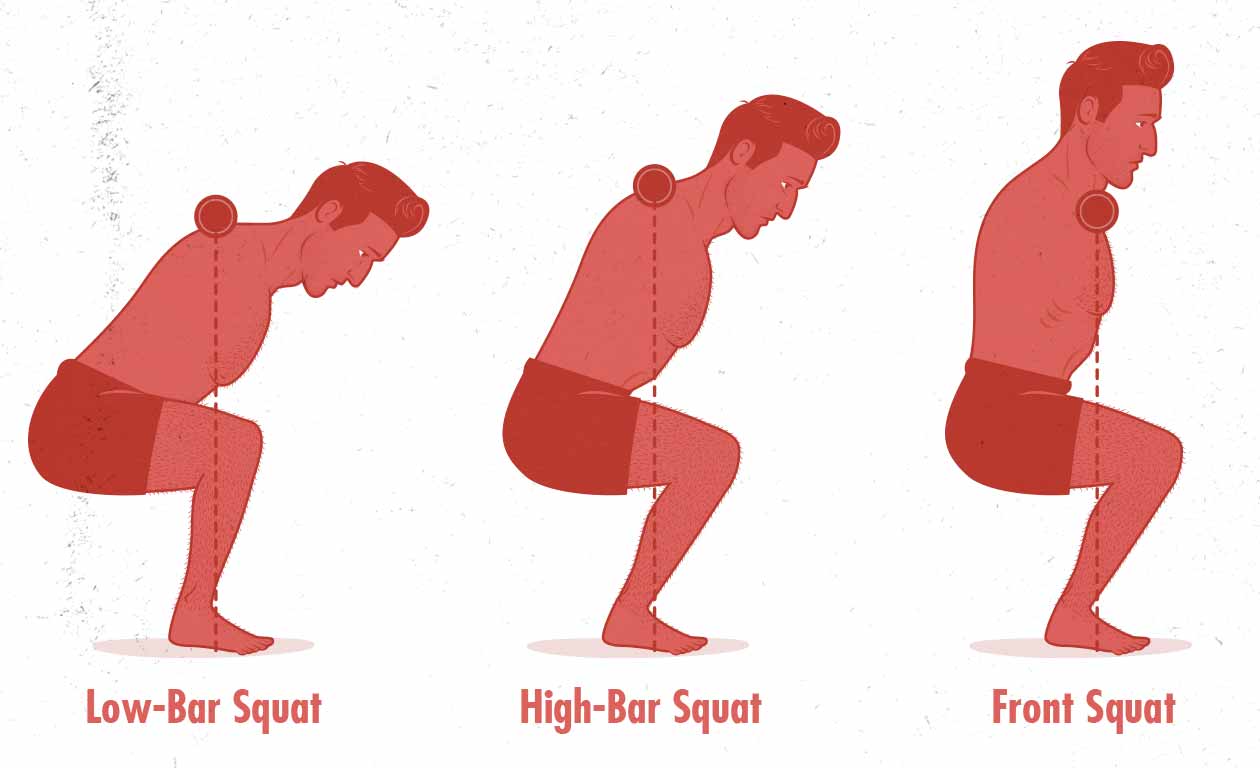
As you can see, the high-bar squat is a sort of hybrid between the low-bar squat and the front squat. This makes it a great all-around squat, and it’s popular in a lot of general strength and powerbuilding programs.
However, most people can low-bar squat about 10% more weight than they can high-bar squat, making them extremely rare to see at powerlifting meets. As a result, you’ll see many high-level lifters preaching the benefits of the low-bar over the high-bar—because of its better carryover to powerlifting competitions.
Even with the lower weight, though, the high-bar squat tends to be better for bulking up. It uses a larger range of motion, there’s more space in the hips, and it’s a bit better for bulking up our back muscles. You’ll even see many powerlifters squatting high bar when they’re trying to gain mass.
Front squats are perhaps slightly better on average, but high-bar squats are a great alternative, and I recommend swapping them into your routine sometimes.
Conclusion: This is a rad all-around squat. Ain’t nothing bad to say about it. If you aren’t fond of front squatting, high-bar squats are a great choice.
Machine Hack Squats
Machine hack squats have your back and shoulders pressed into pads, making squatting easier on your lower back and postural muscles. Most people benefit from training their lower backs and postural muscles, but sometimes it helps to have a variation that gives them a break, especially if they’re already overworked.
Bodyweight Squat Variations
Without weights, we won’t be able to put much stress on our spines or stimulate much growth in our spinal erectors, but there are a few bodyweight squat variations that are great for building muscle in our quads and glutes:
- Bodyweight “air” squats
- Split squats & Bulgarian split squats
- Reverse lunges & walking lunges
- Pistol squats (holding something for balance)
- Step-Ups
There are a couple of accessory movements that are great for just our quads, too, such as:
- Sissy squats (if your knees are strong)
- Kneeling bodyweight knee extensions
Anything that challenges the strength or work capacity of our muscles can provoke muscle growth. However, we need to keep the hypertrophy principles in mind when trying to build muscle with bodyweight training:
- We should still lift in moderate rep ranges (of 5–40 reps per set): if we do more than twenty reps per set, our pain tolerance can become a limiting factor instead of our muscle strength. If we’re doing more than forty reps per set, we stop stimulating as much muscle growth and we start making endurance adaptations instead.
- We need to make sure that balance isn’t the limiting factor: if we’re concentrating more on keeping our balance than on working our muscles, we won’t be limited by our strength, and so we won’t provoke muscle growth.
- We need to lift closer to muscular failure: when squatting in moderate rep ranges of 5–10, our muscles will often give out before our cardiovascular systems and pain tolerances start to limit us. Even when we stop shy of failure, our muscles have still been challenged enough to grow. With bodyweight training, though, the rep ranges can get quite a bit higher, and we’re more likely to stop our sets because we’re tired or in pain, and it becomes all the more important to endure all the way until our muscles actually start to give out.
So when it comes to choosing bodyweight squat variations, we need to find variations that are heavy enough to cause muscle failure before forty reps and ideally before twenty reps (which might disqualify air squats). We also need to ensure that the lift is fairly sturdy so that our balance doesn’t limit us (which can be a problem with pistols quats). But if we can do that, then we can build just as much muscle with bodyweight squat variations.
The easiest way to make bodyweight squats heavier is to train one leg at a time (unilateral). If we can do forty air squats in a row, we may only be able to do twenty split squats (per side). As a result, the best bodyweight squat variations tend to be one-legged.
A fairly easy way to fix all those problems, of course, is to do pistol squats while holding onto something for balance. That way, we’re getting the challenge of pistol squats without our stability being the limiting factor.
The next trick to make bodyweight squats harder is to keep constant tension on our quads. To do this, we simply avoid locking out at the top of the lift. That’s going to keep our blood trapped around our quad muscle, giving us a bigger pump, limiting the number of reps we can do, and allowing us to get more muscle growth with fewer reps. (Taking this concept one step further, we can even experiment with blood-flow restriction training.)
Now, it’s true that using a larger range of motion tends to lead to greater muscle growth, but the most important part of the range of motion is getting a stretch at the bottom of the lift and then lifting through the sticking point (which is just above parallel). Because the very top of the squat is so easy, it won’t really stimulate any growth.
Furthermore, nothing is stopping us from adding a bit of external load. If we load up a backpack with books and hold it in front of ourselves, we now have a way to gradually make our Bulgarian split squats heavier over time.
Another cheap way to make bodyweight training heavier is to get resistance bands. The strength curves of resistance band lifts aren’t quite as good as barbells and dumbbells, but they’re still quite effective for stimulating muscle growth.
Bulgarian Split Squats
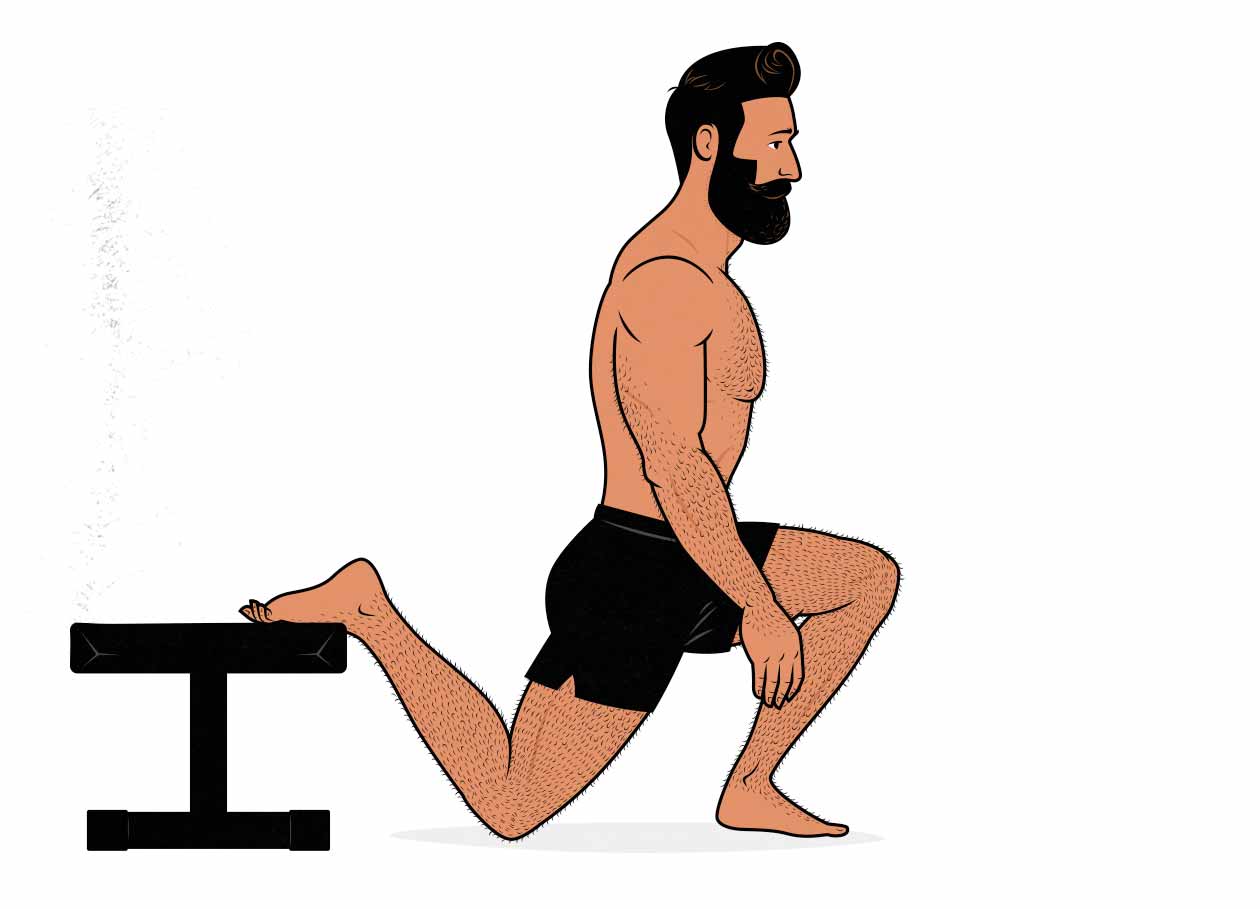
Split squats are good, but the range of motion tends to be fairly limited and our back legs can help contribute to the lift, allowing us to do more repetitions before hitting failure. To solve both of those problems, we can raise our back legs up, giving us the Bulgarian split squat. It will still take some practice before balance stops being a factor, but because we have our back legs balanced on a chair or bench, we have more stability than with a pistol squat.
Pistol Squats
Pistol squats are one of the harder bodyweight squat variations. The problem is that they require quite a lot of mobility, stability, and balance, meaning that until we’re quite skilled at them, our strength is unlikely to be the limiting factor, so they won’t stimulate much muscle growth. The solution to that, though, is simply to hold onto something for balance until you don’t need it anymore.
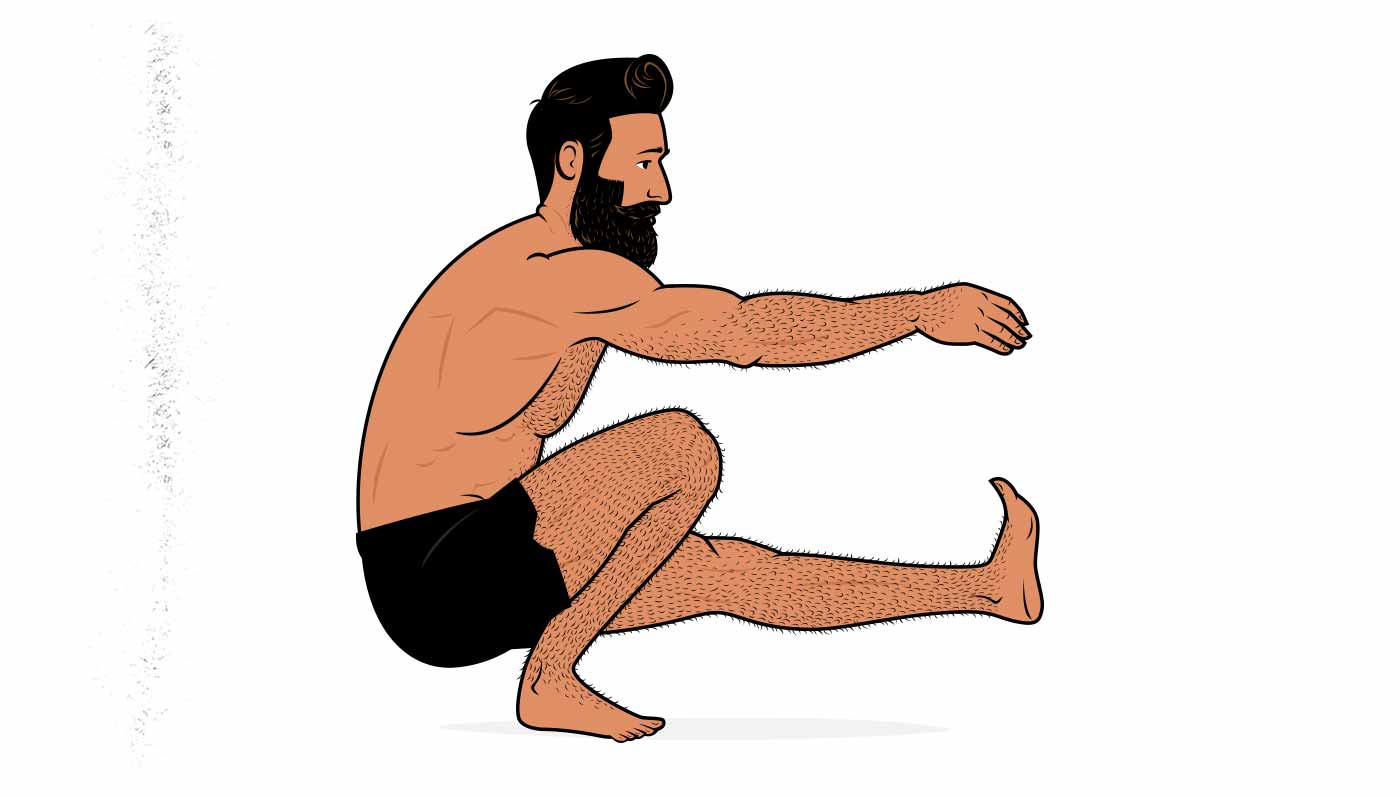
The next way to make pistol squats better for building muscle is to avoid taking the tension off of our muscles at the top or bottom of the lift. It is good to get a stretch on our quads at the bottom of the lift, but we don’t want to rest there. And it is good to squat above and the sticking point (which is when our thighs are horizontal), but we don’t need to fully lock out the lift at the top. This makes the lift a bit harder, allowing us to get the same amount of muscle growth without needing to do as many reps.
Step-Ups
Step-ups with a low step are a great bodyweight squat variation for beginners, and then as we become more advanced, we can gradually raise the step higher. Step-ups are also easy to add external load to, such as a backpack full of books.
How to Increase Your Squat Strength
Diagnosing Weak Links
When your squat strength plateaus as a beginner, the solution is usually to spend more time squatting or to gain more weight. Spending more time squatting will train the muscles that you need to improve at the squat, and eating more calories will allow those muscles to grow.
However, as an intermediate lifter, it pays to pay attention to why you’re unable to add more weight or eke out an extra rep. If your back is giving out, we can sneak in a bit of extra back work. If your quads are giving out, we can sneak in a bit of extra quad work.
Now, that extra work could come in the form of extra squatting, sure, but squats are damn hard. There’s only so much squatting you can do. If your back is giving out, it might be easier to address that with smaller, lighter, easier assistance and accessory exercises.
The first step to fixing a weak link is to figure out where that weak link is.
Your squat will fail for one of three reasons:
- Your upper back rounds because it isn’t strong enough to support the weight. This is especially true with front squats, which means that your spinal erectors are your limiting factor. If you’re eager to bulk up your upper back, that’s great news. Your back will grow stronger simply by continuing to do front squats. However, you can speed up your back growth even more with conventional deadlifts, bent-over rows, and good mornings. Using a lifting belt and improving your bracing technique can also help.
- Your hips shoot up at the bottom of the squat because your quads aren’t strong enough to lift you up. If this is happening while front squatting, remember to keep your torso upright while squatting. But this rarely happens with the front squat. It’s more common with low-bar and high-bar squats. To fix this, we simply need to strengthen your quads. You could do that by switching to front squats, of course, but you could also use the leg press, hack squats, step-ups, and split squats.
- Your form doesn’t crumble, but the bar won’t rise because your hips aren’t strong enough. This, too, is more likely to occur with the hip-dominant squat variations, especially if you “sit back” into a low-bar squat. You can bring up weak hips with more hip-dominant squatting, but you could also use glute bridges, hip thrusts, deadlifts, and Romanian deadlifts.
- Your quads run out of gas just above parallel. Great. This is a normal place to fail. More front squatting will fix this, but so will choosing quad-dominant assistance and accessory lifts.
Assistance Lifts for the Front Squat
As a beginner, there’s a good argument to be made for practicing the main lifts more often. For example, a beginner might do goblet squats 2–3 days per week instead of using a variety of different squat variations. However, as an intermediate lifter, there are some advantages to bringing in assistance lifts:
- For general strength, assistance lifts are similar to the main variations, but they’re specifically designed to help us double down on our strengths or to fix a weak link.
- For general health, adding in this extra variety will give our joints and connective tissues a break from doing the exact same movement over and over again.
- For aesthetics, assistance lifts work our muscles in a slightly different way, stimulating new muscle fibres and helping us to develop fuller muscles.
However, if you’re new to the front squat and you want to speed up the learning curve, it’s perfectly fine to do more front squatting instead of using assistance lifts.
Squat to a Box
Squatting to a box can help correct our tendency to squat with a shorter range of motion as the weight gets heavier. This is important because if your range of motion is getting shorter as the weight gets heavier, you aren’t actually giving your muscles a greater stimulus. You’d just make the lift easier to account for the heavier weight.
If you practice squatting to a box for a few weeks, your squat depth should become more consistent. Problem solved.
Squatting to a box is separate from a box squat. There’s a squat variation called the box squat, where you squat down to a box, sit on it, and then squat the weight back up. This isn’t that. Squatting to a box is where you do your squats just like normal, but you tap your butt against the box at the bottom of every rep.
Zercher Squat
If you have trouble keeping your upper back from rounding while front squatting or deadlifting, the Zercher squat will do a good job of strengthening your upper back muscles.
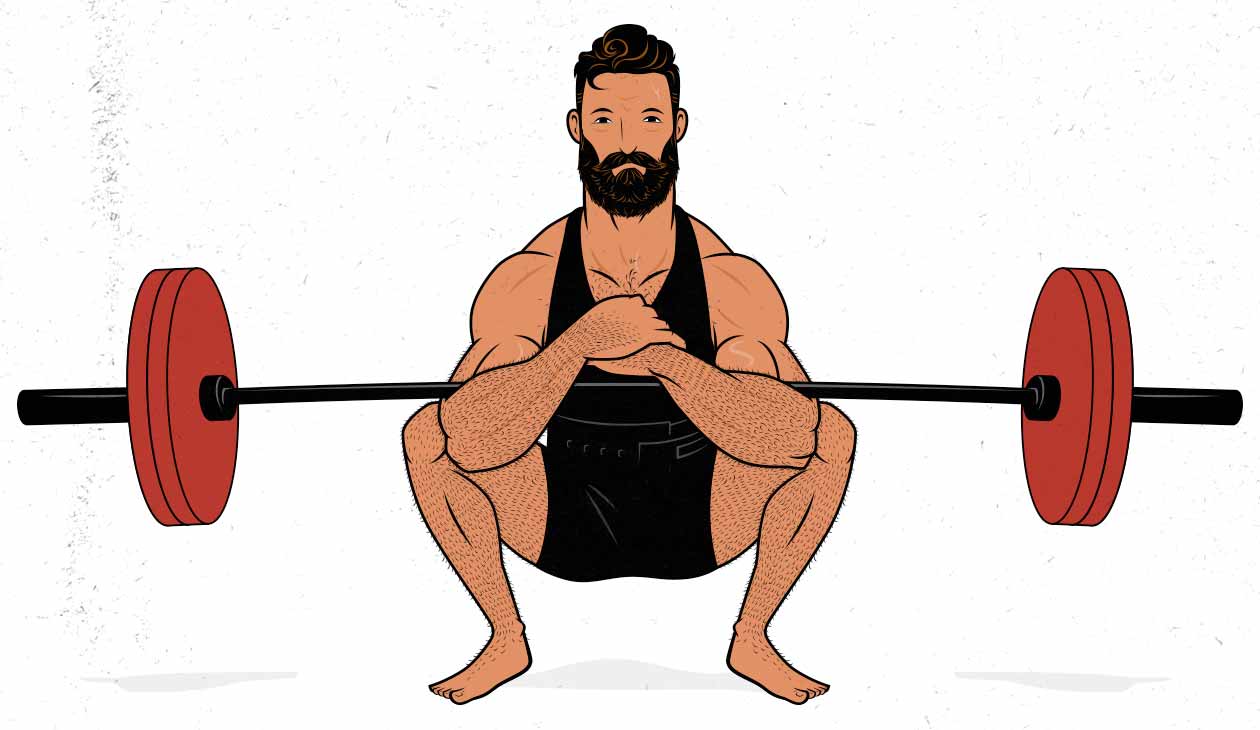
Zercher squats are where you hold the barbell in the crook of your elbows, down near your abs. These make a good accessory lift for both the sumo deadlift and the front squat, given that it works a number of the same muscles:
- Quads
- Adductors
- Glutes
- Spinal erectors
- Upper back
- Traps
- Biceps
Like the front squat, holding the weight in front of you will allow you to keep a more upright torso and squat with a deeper range of motion. However, many people are able to go sink deeper when doing Zercher squats, which is another reason why they’re such a valuable assistance lift.
The main downside is that it’s hard, and it hurts. Plus, it’s hard to lift as heavy on the Zercher squat as you can go on a front squat, with the biceps often being the limiting factor.
Accessory Lifts for the Front Squat
Accessory exercises will help make you even bigger, stronger, and better looking. In one study, the researchers compared the muscle development of people doing just squats compared with doing squats, leg presses and leg extensions. The volume was equated, so both groups were doing the same amount of lifting overall, and so as you’d expect, both groups gained the same amount of muscle mass.
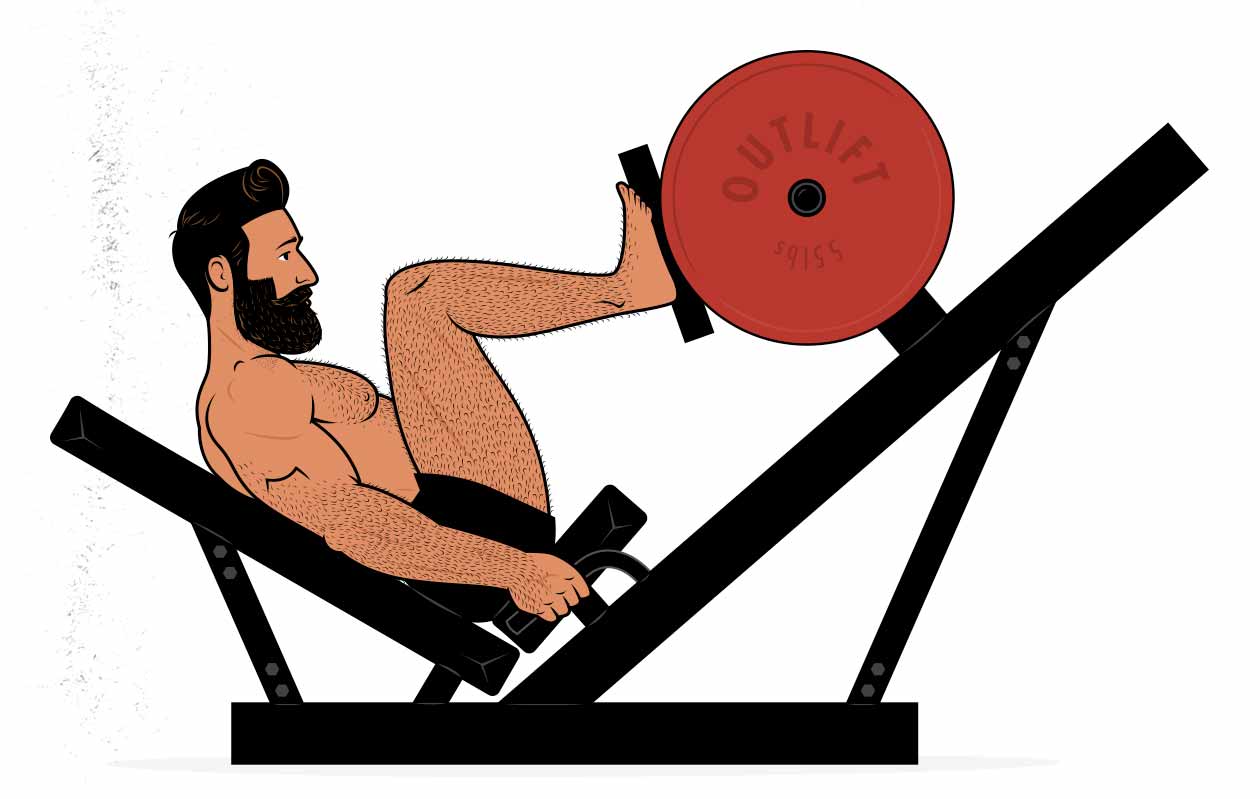
What was cool, though, is that the participants doing a greater variety of exercises got more balanced muscle growth. All four heads of their quads grew proportionally. Surprisingly, adding in those accessory exercises even resulted in a greater increase in squat strength.
However, as we mentioned above, if you’re still learning the lifts, there’s a good case to be made for practicing them over and over again until your technique is solid. So if you’re still struggling with your front squat technique, it may be best to stick to front squats and goblet squats until that groove is fully greased.
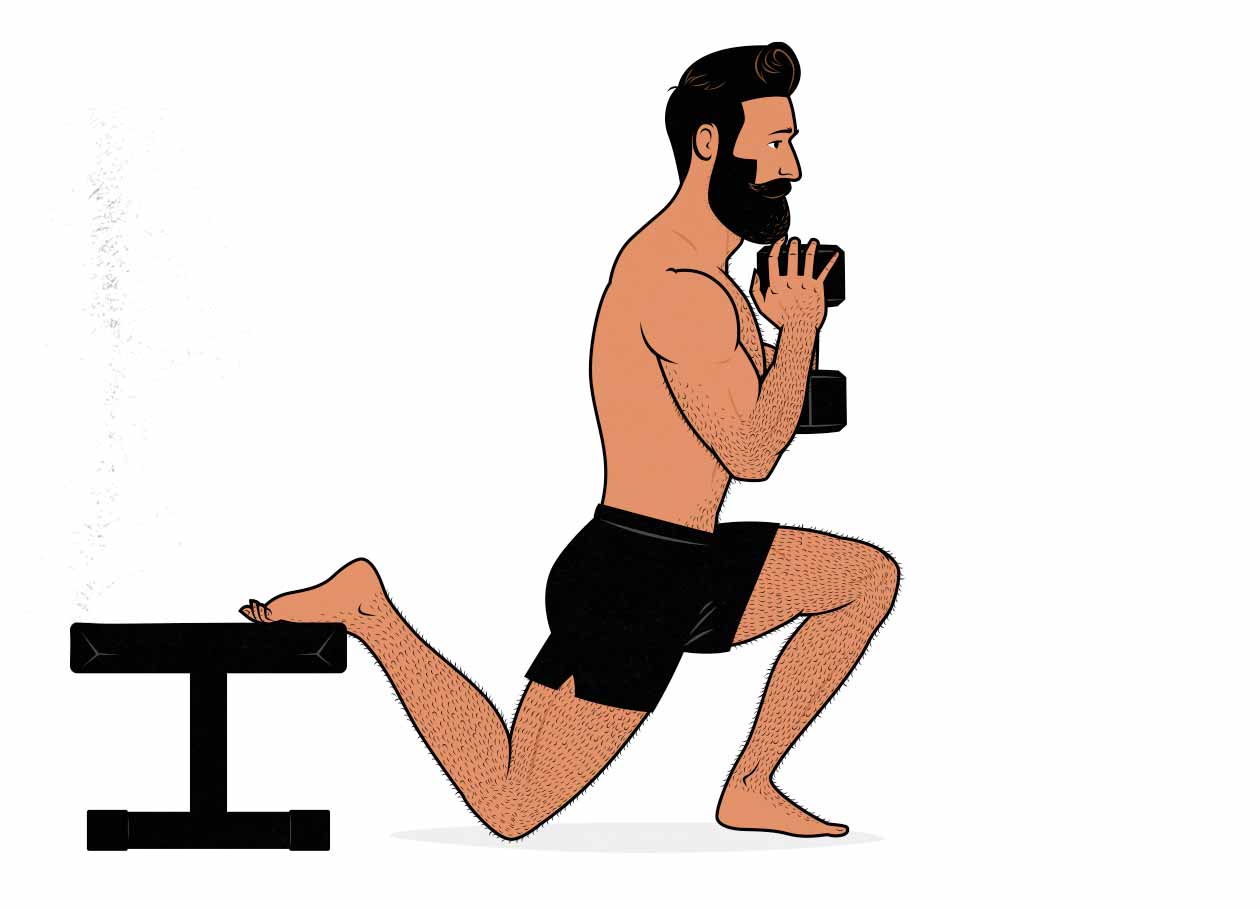
But once you know how to squat properly, you don’t need that same relentless practice, and you can capitalize on the benefits of exercise variation.
The list of accessory lifts for the squat is endless, but here are our favourites:
- Leg press: the leg press is fairly heavy while limiting the stress on your back muscles, allowing you to emphasize your lower body. If your quads are holding you back on the squat, the leg press is a great choice.
- Good morning: if your squats (or deadlifts) are limited by your back strength, good mornings are great for bulking up your spinal erectors. They’re good for your hips and hamstrings, too, making them a great accessory lift for both the squat and deadlift. If your quads aren’t limiting you on the squat, these are a solid choice.
- Step-up: this is another great exercise for bulking up your quads. Step-ups tend to be a bit easier and lighter than the leg press, allowing you to toss them onto the end of a tiring workout.
- Leg extension: this is another good way to bulk up your quads. However, leg extensions only bulk up your quads, making them fairly inefficient.
- Split squat: split squats work well but are a nightmare to do, making them a suitable exercise choice for people who hate themselves but still want awesome results.
- Bulgarian split squats: similar to split squats, Bulgarian split squats are a bit of a pain to learn and a bit of a pain to do, but they’re extremely effective for bulking up the quads.
If your hips lag behind your quads, you could switch to a low-bar squat position to emphasize your hips a bit more. However, keep in mind that we have a whole movement pattern designed to bulk up your hips: the deadlift.
So if your hips are lagging behind, that might be a reason to deadlift more often or to use more deadlift accessories (such as hip thrusts and Romanian deadlifts).
How Much Weight Should You Be Able to Front Squat?
How much can the average man expect to squat? Most strength standards measure the low-bar back squat, not the front squat. However, most people can front squat roughly 75% as much as they can back squat, allowing us to take the strength standards from ExRx and make some estimations.
If you’re new to lifting and you’ve never front squatted before, you might be able to lift somewhere in the neighbourhood of 115 pounds for a single repetition. Mind you, according to data collected by the CDC, the average man is 5’9 and 197 pounds, with a BMI of 29, making him just shy of obese. If you’re taller or lighter than that, you may find that you aren’t able to lift quite as much.
Most people already have enough muscle mass to front squat more than 115 pounds, it’s just that they aren’t very good a the lift yet. Hell, most beginners can’t even front squat at all, let alone with much weight on the bar. But with a couple of months of practice, the average novice lifter can front squat around:
- 170 pounds as their 1-rep max.
- 150 pounds for 5 reps.
- 135 pounds for 8 reps.
As you continue gaining muscle size and strength, your front squat numbers will climb ever higher. After a year of serious training, the average man can lift:
- 245 pounds as their 1-rep max.
- 215 pounds for 5 reps.
- 200 pounds for 8 reps.
And if you keep pushing closer to your genetic potential, the average man can expect to front squat:
- 355 pounds as their 1-rep max.
- 310 pounds for 5 reps.
- 285 pounds for 8 reps.
Now, these final numbers might seem high. If you go to the typical gym, you won’t see guys front squatting 355 pounds very often. You might not even see guys front squatting at all. But if you really want to become strong, you should be able to achieve these front squat strength standards, even if you started off quite skinny.
If you’re interested in developing maximal strength, you can train for and test your 1-rep max. But if you’re interested in gaining muscle size and improving your general health, testing your rep maxes is probably wiser. By testing your rep maxes, you’ll have just as good of an idea of how strong you are, but you won’t need to train for it or peak for it; you can just take your working sets to failure. Feel free to gauge your strength by seeing how much you can lift for 8 repetitions.
For more on strength standards, we have an article on how much the average man can lift.
Summary
Front squats are arguably the best muscle-building lift of all time and are great for stimulating growth in the two biggest muscles in your body: the quads and glutes. That isn’t to say that other squat variations aren’t similarly good, though. All of them have their own unique advantages and disadvantages. The front squat is best for building muscle and improving aesthetics, the low-bar squat lets you lift the heaviest, and the high-bar squat is a good compromise between the two.
The reason the front squat is best for building muscle is that it works your quads through the largest range of motion, stimulates growth in your upper-back muscles, it’s easiest on your joints, it carries a lower risk of injury, improves your posture, and it’s the least fatiguing. Plus, the front squat is extremely knee-dominant, making it more distinct from the deadlift and thus adding more variety to your workout routine. But even so, you can pick whichever squat variation you prefer. All of them are great.
The main downside to the front squat is that it’s hard for beginners to learn. That’s why starting with a goblet squat is often the best way to ease into it. It has all the same advantages, it’s just harder to load as heavy. But for a beginner, that isn’t a problem yet. Until you can do 10+ reps with the heaviest dumbbell (or weight plate) you have access to, there’s no need to switch over to the front squat.
To increase how much weight you can front squat, your routine should include plenty of front squatting. But you can also use assistance lifts to help practice the general movement pattern, adding a bit of variety to your workout routine. The Zercher squat pairs well with the front squat since both have the weight held in front, allowing for a more upright torso. Another good assistance lift, especially if you’re having trouble hitting consistent depth, is the squat-to-a-box, where you tap your butt against a box (or whatever) at the bottom of every rep.
You can also use accessory lifts to stimulate extra growth in your quads, hips, and upper back with entirely different movement patterns. For example, the leg press is a great lift for bulking up your quads in a way that transfers well to the front squat. Or, if you want to improve your leg aesthetics, it can help to include some knee extension exercises, such as doing leg extensions on an exercise machine. These help to bulk up the area of your quads (the rectus femoris) that isn’t trained very well with squats.

If you want a customizable workout program (and full guide) that builds these principles in, then check out our Outlift Intermediate Bulking Program. If you liked this article, you’d love the full program. Or, if you’re still skinny or skinny-fat, try our Bony to Beastly (men’s) program or Bony to Bombshell (women’s) program.



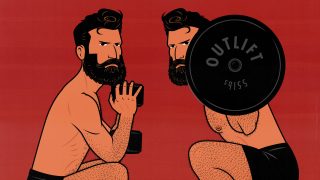

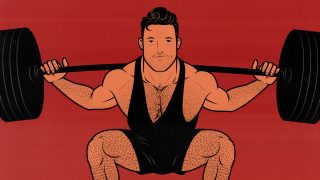
You, guys, are the reason to go back to the front squatting. I’ve tried it not long ago and soon after this I’ve ditched, but after reading your article I am ready to do this exercise again.
What is your opinion on the hips and knee bending- should it be simultaneously or some of the joints should lead?
And i don’t want to become pesky, but is overextending the lower back bad just for the max weight we can lift or it is generally something not good? 🙂
That’s awesome 🙂
Normally you want the hips and knees to move together. But problems only tend to arise if the knees lead. If that happens, it can help to think about breaking with your hips first.
We normally recommend keeping a neutral spine when lifting. Not necessarily perfectly neutral—a few degrees or flexion or extension is perfectly fine—but within the neutral range. That will minimize shear stress on the spine, it will give you a good range of motion, and it’s a very strong position.
Some experts, such as Mike Israetel, PhD, recommend doing high-back squats with an arch/extension for hypertrophy training/bodybuilding. That’s perfectly fine, but it will tend to limit your range of motion at your hips, and you won’t be able to sink as deep. An arched spine also means a bit more shear stress. And because your spinal erectors will be at shorter muscle lengths, you won’t stimulate quite as much muscle growth in them. For more, here’s our article on why training at longer muscle lengths stimulates more muscle growth. But again, it’s not wrong to squat with an arch, either.
Thanks for the fast and detailed answer, Shane!
Concluding from your answer, it looks like that in the fitness world the things are like everywhere else- there are no wrong ways, just some advisable and preferable ones.
Many folks out there squat and deadlift with hyperextension in the back, because of the fear of arching it, which according to some “experts” on the internet would lead to immediate explosion of the spine. 🙂 All that stuff with the weak abdominals and etc. might be true, but only for some of the people with overextended backs.
I personally do the squat quite fluid, but I believe, if there is a slight difference in the moment of bending, that as a hip dominant guy, my knees are second after the hips.
Anyway, one more time- thanks for the answer!
I do think there are plenty of wrong ways. Just that there are also plenty of right ways.
Arching and hyperextension of the back are the same thing. Most people fear rounding the back, aka spinal flexion. And it’s true that excessive rounding of the back does dramatically increase shear stress on the spine.
Some of these experts recommending against going outside of the neutral range—either arching or rounding—when lifting include guys like Dr Stuart McGill, the foremost expert in the field of spinal health. So it’s not woo or anything. Not that your spine would explode, just that risks go up. I agree with you that the risks are often exaggerated. But even so, most people want to minimize the risks, especially since there’s little downside to doing so.
Thanks for detailing the answer, Shane!
My pleasure, man!
Hi Shane, I liked this article.
I have recently restarted squats, front squats basically. My goal is to use them primarily for general fitness, work capacity, overall physical & mental toughness, etc. Strength and hypertrophy shall be back end by product. So I am using 4-5 sets of 10-12 reps for this purpose with quite challenging weights.
Squatting doesn’t go very well with my anatomy bcoz I am extremely posterior chain dominant so I am keeping them moderate rather than going in all out heavy/strength rep range.
Hey Farhan, thank you!
Yeah, that makes sense. Moderate-rep sets of squats for 10–12 reps are great for improving general fitness, work capacity, and grit. You’ll gain a ton of size and strength, too 🙂
Shane, plz refer to the image of front squats with two dumbbells as appearing in this article. What difference shall it make if one side of each dumbbell is resting on shoulder and dumbbells are in vertical/upright position instead of horizontal position? I do front squats this way and want to know if there would be any difference regarding upper back engagement bcoz now weights shall be resting on front delts.
So the trick with front squats is to make sure that you’re actually challenging your quads. After all, it’s possible to be limited by your back strength. When doing them with dumbbells, it becomes all the trickier because now you can be limited by arm strength, too. So what you want to do is hold the dumbbells in a way where you aren’t limited by your arm strength. Resting them on your shoulders is good for that, so is keeping them above your joints to minimize the moment arms. It’s up to you. Whatever is more comfortable.
As for your upper back, simply having them in front of your body will be great for your upper back. But think more about challenging your quads. We aren’t trying to turn it into an isolation lift for your arms or upper back.
Thanx for the response Shane.
My pleasure, man!
Hi – I just wanted to mention that this article is absolutely fantastic. I really like the illustrations too.
Keep up the great work!
Thank you so much, Ryan! That really means a lot 😀
According to the link you provided, the average man is 69 inches tall, which is 5’9″ not 5’8″. Based on the average weight of 197lb, his BMI would be 29 – just shy of obese.
Thank you for catching that, Jeremy. I’ll update it now 🙂
Great article. If I lack the mobility to front squat with good form (hold the bar near my collarbone). What stretches should I be doing? You mentioned wrists. Anything else?
Hey Courtney, thank you!
If you check out the front squat video, Marco goes over a good stretch for developing that mobility 🙂
Shane, what do you think of jump squats (bodyweight, weighted, and split-squat variations) as an alternative to leg extensions for the rectus femoris? I’ve read some research that at a 2-minute glance seems to suggest it has reasonable rectus femoris activation (see this study), and I’ve been considering it as a compound exercise for calves and rectus femoris. I also was under the impression that the quads have a relatively low fiber activation rate and including some plyometrics is good to force them to respond.
Hey Patrick,
Regarding jump squats and other plyometrics, they’re more of a tool for converting strength into power than for building muscle. See our article on Olympic weightlifting for a more detailed breakdown of why, but to make a long story short, there’s very little time under tension, and so it would take a tremendous amount of reps and sets to get the same benefit as a few sets of traditional bodybuilding-style training.
If you don’t have access to weights and bodyweight exercises are too light, doing jump squats or clap push-ups can help, but unless there’s no other choice, or unless you’re specifically trying to improve your explosiveness, I wouldn’t bother with them.
For the rectus femoris, you’ll get the best growth with exercises that involve less movement at the hips. Flexing the rectus femoris causes you to extend your knees (which helps with the squat) and bend at the hips (which hurts the squat). That’s why, for maximal rectus femoris growth, we recommend something like a leg extension. It’s not totally necessary, though. It’s mainly bodybuilders who care about maximizing the growth of all the heads in their quads. For more casual lifters, it’s usually not a big deal if someone can’t do leg extensions. They can stick to squat variations instead.
For your calves, again, best to avoid plyometrics and stick with bodybuilding style training. Standing calf raises are ideal. But, as with the rectus femoris, maximizing calf growth is normally something that only bodybuilders care about, so it’s up to you how much calf training you’d like to do 🙂
Shane – What is your take on using a belt for heavier front squats, when closing in on your 1RM lift? Does that defeat part of the purpose of the lift?
Hey Josh, I think belts can be great! We’ve got an article going over the pros and cons. Long story short, it will give you sturdier torso, which can be a limiting factor when front squatting. I think you’d build more muscle overall. I’ve gone through periods of doing front squats with weight belts. Right now, I don’t use one.
I’m sort of crashing the party here, because I am 70 years old, which makes me radically different in capacity and aspiration than everybody else who posts. But I may actually have some valuable advice for the young.
At 70, my principal exercise goal is just to maintain the health of my joints and lower back. That’s it, and when you’re old it is a very big it. I do three calisthenics every day: push-ups (I can do eight!), sit-ups and deep knee bends. Of those three, the deep knee bends yield the greatest benefits.
A deep knee bend is not quite the same as a squat. You stand, you bend your knees, and go down all the way, until you’re sitting on your heels. I put my hands down and touch my fingertips to the floor at the lowest point, which keeps me from toppling over. (At age 70, toppling over is hazardous.) I can do 50 of these in a little more than two minutes, and at the end of the set my quads are pretty much played out.
But I’m telling you, this is a wonderfully beneficial exercise. It produces healthy, pain-free hips, knees, ankles and feet. Before I began my deep knee bend program, my feet would go numb. The deep knee bends have made that problem go away.
This information is unlikely to be of any great use to the young studs who frequent this site, but I thought I’d share it anyway. Time goes by and, if you don’t die, you get old. And, in my experience, deep knee bends go a long way to maintaining health in old age.
Dumbbell Bulgarian squats should I do deficit Bulgarian squats?
A good rule of thumb is to go as deep as you can, provided the exercise is still stable, suits your body, and still lets you lift a reasonable amount of weight.
This article doesn’t mention that front squats are not very efficient to do in higher end rep ranges for example 10-12.
as much as I love front squats don’t you think that front squats remove a bit of practicality from the main goal of hypertrophy.
Hey Jay,
What’s your argument for why front squats aren’t good for sets of 10–12 reps?
What do you think is more practical?
Hey, Shane
By the time I get into the higher rep ranges like above 8 reps my back starts to fail before my quads and lower body. Form starts to inevitably break down. I like the posture adaptations and back strength from the front squat but for optimal lower body hypertrophy something like the hack squat or leg press would seem more efficient for quad hypertrophy because that’d be the limiting factor rather. I’m also curious do you still front squat often or have you switched up your approach to lower body training?
Okay, I see what you’re saying. Front squats are kind of like deadlifts. Depending on how you do them and where you’re strongest, you can just as easily fail based on back strength as lower-body strength. I see this more as a feature than a problem, but if you wanted to isolate your legs, it’s definitely not ideal. In your case, it sounds like sets of 6–8 reps might be ideal. That way you’re limited by the strength of your legs, but your back is plenty challenged, too. That might get you the best of both worlds.
I agree with you that the leg press is an absolutely killer movement for isolating your lower body and bulking up your quads.
I use the front squat as my main squat variation, yeah. Right now, I’m maintaining my size and strength while I work on improving my cardio. The only two exercises I do for my lower body are the front squat and Romanian deadlift. When I’m bulking, I add in a bunch of other variations. Sometimes I’ll swap the front squat for a high-bar squat.
Hello!
Thank you for this very helpful article. For hypertrophy, how many sets and reps of the front squat do you recommend? What about for strength?
My pleasure, Abby!
When you’re starting a new routine, it helps to ease into the exercises. I’d start with 2 sets, and then work your way up to 3–5 sets (in each workout where you do front squats). The more important thing to consider is how many sets you’re doing per muscle per week, though. Front squats are mainly a quad exercise, so count out how many sets you’re doing for your quads per week. You want at least 10, and perhaps closer to 20. If you’re really focused on your legs, maybe even more!
For powerlifting strength (to increase your 1-rep max), you might want 4–6 sets, but you won’t need to push as close to failure. I’d do sets of 1–6 reps and stop about 3 reps away from failure.